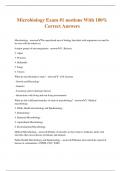Exam (elaborations)
MN 551 Midterm Exam - Question and Answers (LATEST)
- Course
- MN 551 (MN551)
- Institution
- Purdue University
1. A patient is experiencing impaired circulation secondary to increased systemic arterial pressure. Which of the following statements is the most relevant phenomenon? 2. A nurse practitioner employed in a hospitalist notices that a patient is experiencing muscle atrophy following 2 weeks in tra...
[Show more]












